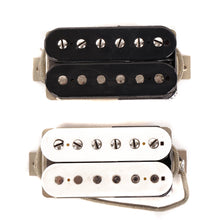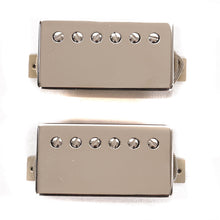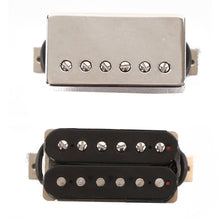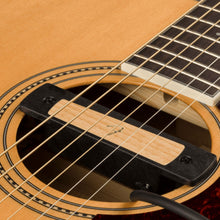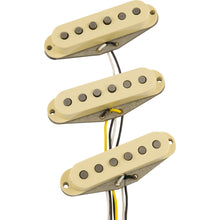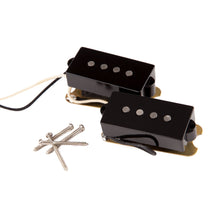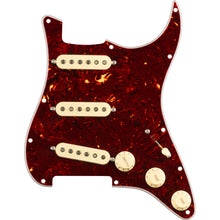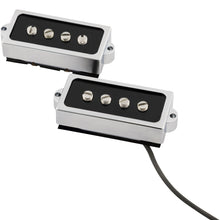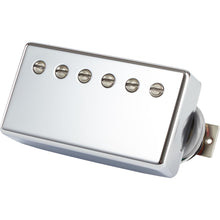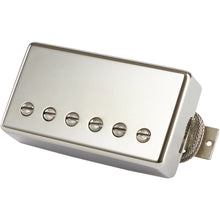Guitar and Bass Pickups
Guitar and Bass Pickups For Sale at The Music Zoo
Buy Guitar and Bass Pickups online now from The Music Zoo! We have a great selection of guitar gear available for purchase in our Guitar and Bass Pickups product collection. Awesome customer service and secure checkout are always included with your purchase. The products listed for sale in this collection are ready to ship immediately, with expedited delivery options available. If you're looking to make monthly payments, financing options for your Guitar and Bass Pickups order are available on checkout. Your satisfaction is always our top priority, so we offer a no hassle return option on every item we sell.
About Our Guitar and Bass Pickups Product Catalog
A pickup upgrade will surely be a part of almost every musician's learning process and personal tonal development. Here at The Music Zoo, we make it easy with our huge selection - we stock everything from the time-tested classics to the boutique modern day hand-wound examples. Whether you're looking for electric, bass, or acoustic pickup, humbuckers, single coils or P-90s, a set inspired by your favorite player, or a modern active pickup, we're the destination! Buy your next pickup online at The Music Zoo or visit our New York showroom to shop today - we're an authorized dealer for all your favorite pickup brands!
Guitar & Bass Pickups History
As you might guess, the earliest guitar pickups arrived right alongside the first electric guitars. Rickenbacker pickups first appeared in lap steel electrics in the early '30s and then in the mid '30s, the Gibson ES-150, the first mass marketed electric guitar, was loaded with a unique electromagnetic bar pickup with hexagonal edges that was eventually dubbed the Charlie Christian pickup. The highly revered Gibson P-90 pickup first appeared in 1946 - followed by the jazz-player-favorite Dearmond pickups, Danelectro Lipstick pickups, and Valco made single coils of the '50s.
In the mid to late '50s, the development of the modern-day humbucker began. Seth Lover created the first so-called "PAF" or "Patent Applied For" humbucker for Gibson in 1955, under the instruction of Ted McCarty. At around the same time, Ray Butts developed a similar pickup that soon become the Gretsch Filter'Tron. Both of these early humbuckers used reverse polarity coils and reverse winds in order to filter out mostly all noise associated with earlier single coil pickups.
During this era, the P-90 was less popular but still developed further and was blessed with more output, while Leo Fender created his own single coils for usage in his Stratocasters, Telecasters, and Precision and Jazz bass guitars. The tonal character of all of these pickup types took shape in this era as well. Fender single coils were bright, snappy, and twangy, and very responsive to playing dynamics. The Gibson P-90 single coil boasted a similar dynamic range as the Fender single coil, but was a bit higher output and held up better in a more overdriven rig. Humbuckers, while maybe slightly less dynamic, were much thicker and warmer and produced no noise. The Gretsch Filter'Tron humbucker was in general a brighter pickup, while the Gibson PAF had a stronger midrange.
The '60s and '70s saw the introduction of other noteworthy pickup styles, including Fender's Jazzmaster pickups, Gibson's Mini Humbuckers, Fender's Wide Range humbuckers (designed by Seth Lover), and the first aftermarket "replacement" pickups.
Larry DiMarzio brought about the rise of the "replacement" pickup in 1971. This invention spawned an entirely new market, aimed at players looking for more output from their humbuckers at first, but in general, giving tone-chasing players more options aside from the factory pickup options provided at the time. The DiMarzio Super Distortion and Dual Sound humbuckers were the first mass "aftermarket" pickups. These humbuckers were inspired by the lesser-known "True-Sound" pickups of the mid '60s, designed by Bill Lawrence, who would later go on to create his own aftermarket "blade" pickups. Following in DiMarzio's footsteps, both Seymour Duncan and the new "active preamp" powered EMGs also appeared on the scene in 1976 and are still revered to this day.
Advancements in pickup technology have come a long way today, but boutique, hand-wound original-era inspired examples are still at your disposal. Some of the newer advancements include "rail" pickups for even more output, MIDI and synth pickups, specialized acoustic guitar pickups, noiseless single coils, and the new Fishman pioneered Fluence pickups, which act in many ways like a "modeling" pickup. Manufacturers' have even developed ways to mix tone and form-factor like never before - for example if you love the P-90 sound but have a humbucker equipped guitar, you can grab a "humbucker sized P-90" or visa versa! Other recommended modern pickup brands include Bare Knuckle, Fralin, and Nordstrand.
Guitar & Bass Pickup Types
Single Coils
Single coil pickups span the longest time period - they were the first types of guitar pickups created, and still exist today. A single coil pickup is a relatively simple design that uses one of a variety of magnets wrapped many times in thin copper wire. Using different magnets or a different amount of winds, as well as the placement of the pickup in the guitar, will provide vastly different tones. Single coils in the modern day are most often associated with Fender and Fender style guitars, even though Gibson technically made them first. Fender has always used them though and they've become synonymous with the Stratocaster and Telecaster. Single coil pickups generally have a clean and clear sound, with a lot of high end and low end. They can be twangy and bright and also very responsive to pick attack. Blues and country players tend to be right at home on a single coil equipped guitar.
P-90s
Gibson developed the P-90 in 1946, and while this pickup was overshadowed 10 years later by the new PAF humbucker, P-90 pickups still have a loyal following to this day. A P-90 is technically a single coil pickup, but since it uses different "bar" style magnets, it is able to produce more output and a thicker sound than a Fender-style single coil. Because of this, P-90s are a good middle ground between humbuckers and classic single coils. Generally a P-90 comes in one of two form factors - a "dogear" version, where the pickup is mounted to the body via 2 triangular "ears" on the sides of the pickup, and the soapbar version, in which the mounting screws are places in the middle of the pickup, in line with the pole pieces, so no extra mounting surface area is needed.
Humbuckers
The demand for higher output and less noise brought about the invention of the humbucker pickup in 1955, and they remain some of the most popular pickups to date. A humbucker essentially consists of a pair of single coil pickups, arranged in opposite directions and in opposite polarities, which cancels out noise. Aside from this functional feature, humbuckers generally produce a much stronger and thicker midrange, are louder with higher output, and have a slightly rolled off top end and more warmth. Many modern humbuckers can even be wired in ways where a player can use only one of the coils, producing a single coil sound. Humbuckers are generally not as responsive to playing dynamics as single coils, but are beloved by jazz players for their warmth, and metal and hard rock players for their ability to overdrive an amp.
Bass Pickups
Bass guitar pickups evolved to encompass two main styles - the "P" style pickups, as found in the Fender Precision Bass, or "J" style pickups, as found in the Jazz Bass. While humbuckers, and even P-90s have been used as bass pickups, the P and J examples tend to be the most widely used and copied. The "P" style pickup is characterized by a "split" coil design, and while technically a set of two single coils, they are wired together in "humbucking" fashion. "J" style pickups are arranged similarly to pair of guitar pickups and are usually true single coils. Sometimes bass guitars even have 1 of each! Another popular bass pickup type arrived with the creation of the Music Man Stingray bass, which was loaded with a large 4 pole humbucker, now known as an "MM" style pickup.
Acoustic Pickups
The modern "acoustic guitar" pickup saw it's origins in the '70s, when Ovation and Takamine were pioneering the first acoustic pickups that actually made the acoustic guitar sound like an acoustic instrument! Takamine's Palathetic pickup, which uses six piezo transducers under the bridge, a common design still used to this day. Some though, thought that these pickups still sounded a bit artificial, and Barcus Berry introduced an answer to this problem in the later '70s, when their pickups featured a removable transducer that could attach to the soundboard of the instrument and capture the more natural vibrations. These two designs paired well together and led to further innovations by Fishman, LR Baggs, DiMarzio, and Taylor. Taylor even designed their own in-house Expression System electronics, with piezo pickups "behind" instead of "under" the saddle.
Active vs. Passive
The need for more distortion and louder, higher headroom pickup designs led to the dawn of "active" guitar pickups in the mid '70s. Though first developed for Alembic bass guitars in 1969, EMG built the first active guitar humbuckers. These examples married existing pickup technology with a new battery powered preamp. Active pickups such as these tend to have even less noise than passive humbuckers, a ton more output, and a wider frequency response. Because the pickups themselves could be built with weaker magnets and less coil winds, sustain was also boosted because of less magnetic interaction with the strings. Plus, the preamps often had separate EQ controls for even more in depth tone-tweaking. Active pickups are used often for bass, as well as for metal and heavier genres.
On the flip side, passive pickups, which represent the original pickup designs, need to use stronger magnets and more coil winds to produce output. But they tend to have more touch sensitivity and a more organic sound than active pickups, and are beloved by blues, jazz, and rock players. If you can deal with a little noise and want a bit more character in your sound, a passive pickup might be the ticket. Yet both pickup types are equally viable - it's up to the player to decide!


